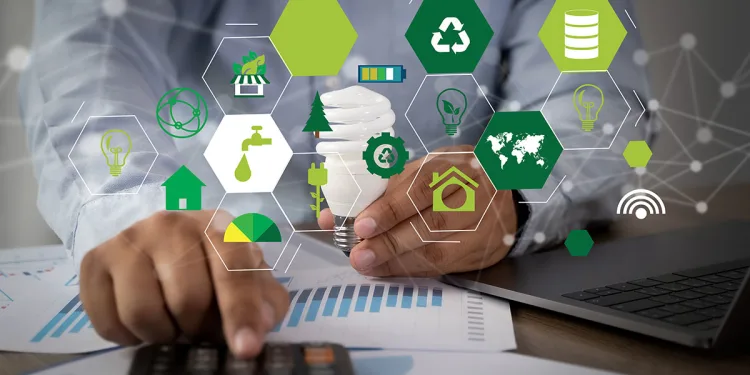
Let’s be honest. For a long time, accounting was seen as the ultimate bean-counting profession. All debits, credits, and profit margins. It was a world of black and white, confined to spreadsheets and balance sheets.
But the landscape is shifting. Drastically. Today’s businesses, especially those built with a green conscience, are realizing that their financial story is incomplete. It’s like trying to describe a forest by only counting the trees you can sell for lumber. You’re missing the ecosystem—the soil, the air, the life that depends on it.
Sustainable accounting, often called green or environmental accounting, is the practice that fills in that picture. It’s about integrating environmental and social costs into your financial decision-making. It’s accounting for the triple bottom line: People, Planet, and Profit.
Why Bother? The Business Case for Going Green on the Books
Sure, it feels good to do the right thing. But sustainable accounting isn’t just a “nice-to-have” for tree-huggers. It’s a powerful strategic move. Here’s the deal.
Investors are increasingly applying a ESG (Environmental, Social, and Governance) lens to their portfolios. They’re looking for companies that are prepared for a carbon-constrained future. A robust sustainable accounting framework shows them you’re not a risk; you’re an opportunity.
Then there are the customers. Modern consumers are savvy. They can spot greenwashing from a mile away. Transparent reporting on your environmental impact builds a level of trust that marketing alone can never, ever buy.
And let’s not forget operational efficiency. Tracking your resource use—energy, water, waste—is the first step to reducing it. And reduction? Well, that directly translates to cost savings. It’s a direct line from sustainability to your profit margin.
Core Frameworks: The Languages of Green Business
You can’t manage what you don’t measure. And to measure your environmental footprint, you need a common language. That’s where these frameworks come in. Think of them as the GAAP for the green set.
Carbon Accounting
This is a big one. Carbon accounting involves measuring the amount of greenhouse gas emissions your company is responsible for. It breaks down into three “scopes.”
- Scope 1: Direct emissions from your own operations. Think company vehicles or your natural gas furnace.
- Scope 2: Indirect emissions from the electricity, steam, or cooling you purchase.
- Scope 3: This is the big, messy, and often most significant one. It includes all other indirect emissions from your value chain—from the business travel you book to the waste your customers generate from your products.
ESG Reporting
While carbon is a part of it, ESG is the broader umbrella. It’s about publicly disclosing your performance on a range of non-financial metrics. There are several standards out there, but the one gaining immense traction is…
The Sustainability Accounting Standards Board (SASB)
SASB (now part of the IFRS Foundation) is a game-changer. It provides industry-specific standards that help you identify and report on the sustainability issues that actually matter to your business’s financial performance. For a clothing retailer, that’s water usage and labor practices. For a tech company, it might be data security and electronic waste.
Getting Started: Practical Steps to Weave Sustainability into Your Finances
This might feel overwhelming. Where do you even begin? You start with one step. Then another.
First, conduct a basic sustainability audit. It doesn’t have to be perfect. Just take stock. How much energy did you use last quarter? How much waste did you send to the landfill? What’s your water bill look like? This baseline data is pure gold.
Next, identify your material issues. Not every environmental metric is critical for your business. Use frameworks like SASB to figure out which ones are. Focus your energy there. This prevents you from getting lost in the weeds.
Then, integrate these metrics into your management accounting. Don’t let them live in a separate “sustainability” report that gets looked at once a year. Include carbon footprint or waste diversion rates in your monthly management dashboards. Make them part of the regular conversation.
And honestly, invest in the right tools. Modern accounting software and dedicated sustainability platforms can automate a lot of this data collection. They turn a monumental task into a manageable one.
Beyond the Numbers: The Ripple Effects
When you start accounting for the planet, something shifts in your company’s culture. It’s subtle at first. You start seeing waste not as a cost of doing business, but as a design flaw. You see a supply chain not just as a source of materials, but as a web of relationships and impacts.
This mindset fosters innovation. It attracts and retains top talent who want their work to have purpose. It builds resilience against future regulations and resource shortages. You’re not just tracking your impact; you’re future-proofing your entire operation.
It’s a shift from being a company that simply exists in the world to one that actively, and accountably, helps sustain it.
A Simple Comparison: Traditional vs. Sustainable Accounting
| Focus Area | Traditional Accounting | Sustainable Accounting |
| Primary Goal | Maximize shareholder profit | Optimize the triple bottom line (People, Planet, Profit) |
| Cost View | Direct financial costs only | Includes externalities (e.g., pollution, resource depletion) |
| Reporting | Financial statements (P&L, Balance Sheet) | Financial statements + ESG/Sustainability reports |
| Timeframe | Short to medium-term | Long-term viability and impact |
| Stakeholders | Investors, creditors | Investors, employees, community, environment |
The Bottom Line Isn’t Just the Bottom Line Anymore
The old model of business, where success was measured solely by the financial figure at the bottom of a page, is fading. It’s being replaced by something richer, more complex, and frankly, more intelligent.
Sustainable accounting is the tool that lets you navigate this new reality. It’s the compass that points toward true, lasting value. It’s no longer about asking, “How much money did we make?” but rather, “What kind of world did we create while making it?”
And that, in the end, is a ledger worth keeping.






